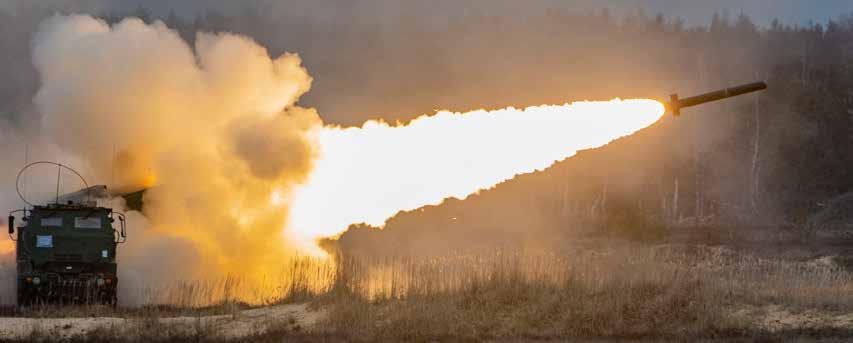
35 minute read
Editor’s Choice for December
December 2019 COT’S PICKS
Marvin Test Solutions Completes SmartCan™ Deliveries to Israeli Air Force
Marvin Test Solutions, Inc. announced that it has successfully completed deliveries of all MTS-3060A SmartCan Universal O-Level Arma ment Test Sets to the Israeli Air Force (IAF).
The rugged MTS-3060A SmartCan™ is the most advanced flightline hand-held test set available, capable of testing all Alternate Mission Equipment (AME) and Aircraft Armament Equip ment (AAE) including pylons, launchers, bomb racks, and pods. Addressing an armament test gap that exists across legacy 4th and 5th gener ation aircraft equipped with Smart weapon technology (MIL-STD-1760), the MTS-3060A enables support for any aircraft and any Smart or legacy armament system.
“The IAF has selected the SmartCan from Marvin Test Solutions as a universal flightline ar mament test set for F-16 and F-15 because of its robust test capabilities,” said Major Dror Hadar from the Israeli Air Force. “With the SmartCan, IAF can replace several obsolete test sets with a single test solution that is smaller, easier to use, and still provides more test capabilities than all the obsolete test sets it replaces.”
“We are pleased to support one of the U.S.’ closest allies with a proven universal flightline test solution that greatly improves warfight er effectiveness,” said Major General Stephen T. Sargeant, USAF (Ret.), CEO of Marvin Test Solutions. “Continuing to gain acceptance worldwide, the SmartCan reduces the time and number of maintainers required to perform all armament testing, including the critical MILSTD-1760 functionality test required to ensure successful Smart mu nitions employment, while reducing logistics and training needs. Fur thermore, the SmartCan provides customers the most cybersecure, hand-held O-Level ar mament test set available.”
Incorporating ad vanced measurement capabilities to support new and Smart muni
Pixus Develops New OpenVPX Chassis Manager
Pixus Technologies, a provider of embedded computing and enclosure solutions, now offers a chassis management module for OpenVPX that is compliant to the VITA 46.11 specification for system management. tions and armament, the MTS-3060A has the capacity to grow as new and more complex weapon systems are added to the inventory. The Smart Can is currently deployed in over 12 countries on multiple aircraft and utilized by the U.S. Air Force Test Pilot School as a Smart weapons simulator for JDAM and AMRAAM.
Marvin Test Solutions, Inc. www.marvintest.com

The SHM200 chassis manager for OpenVPX comes in 0.8” or 1.0” pitch sizes. The unit can plug into a standard 3U VPX backplane slot, with versions with just the P0 connector or the P0/ P1 connectors for access to extended I/O. A 6U panel can also be affixed to plug into a 6U slot. The standard panel interface has RS-232, RJ-45, USB and LEDs.
Monitoring of at least 6 temperature sen sors and 10 fans is available on the SHM200 with custom options available. There is fan PWM/ Tach control, along with 16 digital inputs and outputs. A Level-2 unmanaged 3- port Ethernet hub is also an option.
The Pixus SHM200 solution also includes a Web interface to remotely query the system. The user can import images of their boards. By click ing on the image for each slot, the user can drill down to the monitored status of the module.
December 2019 COT’S PICKS SEGGER’s Ozone debugger adds support for custom instructions
SEGGER just released Ozone V3.10, a major update to its full-featured graphical debugger and performance analyzer. The new release includes support for custom instructions, allowing disassembly of application specific instructions added to the CPU core to tailor it for the particular application. Custom instructions are defined in plugin scripts, which can be easily edited by the user of Ozone or the CPU core designer. The software already comes with a plug-in script for the popular RISC-V PULP extension.
Custom instructions are used to make embedded systems more efficient. Tailoring instructions to a specific application increases speed and reduces power consumption. The use of customized instructions, now available for RISC-V and ARM, is becoming more widespread.
The new release comes with other new features and enhancements as well, most notably a new unified timeline window. The unified timeline window now shows all time-related values in a single window, so that instruction trace, power consumption, and data values can be viewed at a glance, while at the same time reducing the amount of screen real estate being used. Having this information in the same timeline can reveal important system information, especially the correlation between power, data, and code execution.
Ozone works cross-platform for Windows, macOS, and Linux. Like most SEGGER software, Ozone can easily be downloaded and installed without a registration process. Ozone is available for free with a J-Link PLUS, PRO, ULTRA+, or with a J-Trace. Other J-Link models can use Ozone under the terms of SEGGER’s friendly licensing, allowing use for non-commercial purposes as well unlimited evaluation even for the commercial user.

SEGGER www.segger.com
Annapolis Micro Systems, has developed a next-generation WILDSTAR™ 100GbE 6E10 6U OpenVPX Switch. It is SOSA™-aligned and VITA 65-compliant
The 6E10 Switch provides up to 6.4 Tb/s of switching between backplane slots of multiple channels of 100Gb Ethernet. It also has front panel I/O to connect to external data sources.
The 6E10 is a turnkey solution with dense,
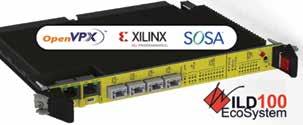
flexible I/O. Customers have the option for seven 40/100GbE optical interfaces to VITA 66, or four 40/100GbE optical interfaces to the front panel.
The rugged high-performance Switch is readily integrated into any SOSA-aligned 6U VPX system, or deployed within Annapolis’ proven WILD100™ EcoSystem. Annapolis has also developed a 3U VPX Switch that is SOSAaligned, the WILDSTAR 3E10 3U OpenVPX Switch.
“Annapolis understood the potential of SOSA early on, and we became a dedicated SOSA contributor and member,” said Noah Donaldson, Annapolis Micro Systems Chief Technology Officer. “We are committed to developing the highest-performing SOSA-aligned products that are first to market.”
December 2019 COT’S PICKS
Curtiss-Wright Announces New NVIDIA ® Quadro ® Turing™ TU104/106 GPGPU Processor Modules for ISR/EW and AI Applications
New GPGPU modules expand Curtiss-Wright’s family of high performance embedded computing (HPEC) processors for artificial intelligence (AI) applications
Curtiss-Wright’s Defense Solutions division announced that, through its Reseller Agreement with WOLF Advanced Technology, it has expanded its family of open architecture high performance embedded computing (HPEC) processors designed for demanding ISR applications with the addition of three new NVIDIA Quadro Turing (TU104/6) GPU/inference engine-based OpenVPX™ modules. Curtiss-Wright also announced the availability of a new AMD Radeon™ (E9171) based XMC graphics engine card. Designed to support computeintensive ISR and EW systems, the fully rugged VPX3-4925, VPX3-4935, and VPX6-4955 modules feature Tensor Cores (288, 384, and 768 respectively) that are ideal for accelerating tensor/matrix computation used for deep learning neural network training and inference used in deployed and artificial intelligence (AI) applications requiring TFLOPS of accelerated processing. These applications include high-performance radar, SIGINT, EO/IR, data fusion ingest, processing and display, and autonomous vehicles.
The size, weight, and power (SWaP) optimized VPX3-4925 module, a 3U OpenVPX GPGPU processor, features a NVIDIA Quadro Turing TU106 (RTX3000E) GPU that delivers 6.4 TFLOPS/TIPS performance. It provides 2304 CUDA® cores, 288 Tensor Cores and 36 ray-tracing (RT) cores. For higher performance in SWaP-constrained applications, the 3U VPX3-4935 module, features a NVIDIA Quadro Turing TU104 (RTX5000E) GPU that delivers 11.2 TFLOPS/TIPS. The VPX3-4935’s higher core count includes 3072 CUDA Cores, 384 Tensor Cores, and 48 RT Cores. For more demanding applications, the 6U form factor VPX6-4955 (6144 CUDA cores, 768 Tensor Cores, 96 RT Cores) hosts dual TU104 GPUs for 22 TFLOPS/ TIPS performance. Designed to work in conjunction with NVIDIA TensorRT™, CUDA, the modules’ Turing Tensor Cores add INT8 and INT4 matrix operation while continuing support for high-precision workloads. These state-of-the-art GPGPU modules further extend Curtiss-Wright’s proven leadership as a supplier of the most advanced computing solutions for embedded ISR applications. To meet demanding rugged military and aerospace specifications, these GPGPU boards feature a chip-down design.
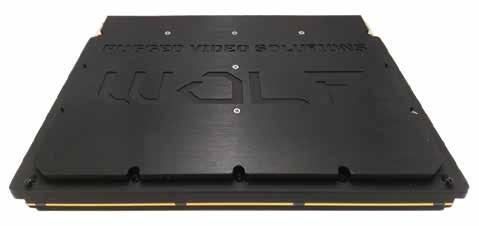
“The introduction of these three new embedded AI-engines brings NVIDIA’s industryleading Turing GPU architecture to deployed defense solutions,” said Lynn Bamford, Senior Vice President and General Manager, Defense and Power. “These newest additions to our family of COTS-based modules further strengthens our commitment to being the embedded industry’s proven and trusted HPEC solution provider.”
Complete System-Level HPEC Solutions The VPX3-4925, VPX3-4935, and VPX6-4955 modules are fully interoperable with CurtissWright’s broad family of 3U and 6U system-level C4ISR/EW OpenVPX solutions. SWAP-constrained systems can pair the single GPGPU VPX3-4925/35 modules with the Intel® Xeon®-D processor-based CHAMP-XD1 DSP engine, and together can augment the powerful sensor processing capabilities of our Xilinx® FPGA-based VPX3-534/535 transceiver modules. For higher performance 6U systems, the dual GPGPU VPX6-4955 can pair with our dual Intel Xeon-D processor based CHAMP-XD2 DSP module and powerful CHAMP-FX4 triple-FPGA processer module workhorse, along with many other modules in Curtiss-Wright’s Fabric40™ family of 40 Gbps products.
Numerous system configurations can be formed using combinations of these boards. For example, a single CHAMP-XD2 node can be used to control both Turing TU104 GPUs on a VPX6-4955, or each node on a CHAMP-XD2 can be mapped to each individual GPU. Taking this design one step further, a single Xeon-D on the CHAMP-XD2 can control one VPX6-4955 board upstream, while the other Xeon-D
maps to a second VPX6-4955 module downstream. This processing slice, consisting of a CHAMP-XD2 and two VPX6-4955 modules, delivers an impressive 45 TFLOPS of performance that can be connected to the rest of the system via multiple 40 Gbps Ethernet/ InfiniBand™ ports available on the OpenVPX data plane, and through a Curtiss-Wright VPX6-6802 central fabric switch.
OpenHPEC™ Accelerator Suite™ Support Curtiss-Wright HPEC modules and systems are supported by the OpenHPEC Accelerator Suite of best-in-class software development tools. These powerful tools enable system developers to develop their software faster. For example, the suite includes the powerful Bright Cluster Manager from Bright Computing, an NVIDIA partner. Bright Cluster Manager provisions and monitors both the CPU and GPU boards, and includes a fully configurable module environment. The OpenHPEC tool suite includes Bright’s deep learning libraries and tools from both Intel and NVIDIA, including Caffe and TensorFlow. It also provides the Arm® Forge suite, which enables true system level debugging and profiling for both CPU and GPUs, and supports MPI, OpenMP, and ACC.
For high-speed, low-latency, peer-to-peer communications, the OpenHPEC Accelerator Suite also includes Dolphin’s PCIe communication library, which hides the complexities of directly programming the system’s PCIe devices. In addition to supporting GPU sharing between the CPUs, the Dolphin library also supports both CPU direct and remote direct memory access (RDMA).
Use of the OpenHPEC Accelerator Suite simplifies, speeds, and lowers the cost of ISR application development. These tools deliver the benefits of open standard High Performance Computing (HPC) software to the COTS market to effectively remove risk when developing large scale embedded computer clusters.
Resulting from its Reseller Agreement with WOLF Advanced Technology, the VPX3-4925, VPX3-4935, and VPX6-4955 HPEC modules have been pre-validated. They complement CurtissWright’s previously announced family of NVIDIA Pascal™ GPGPU modules by speeding and easing the integration of HPEC solutions into deployed systems.
December 2019 COT’S PICKS Acceleration Dev Kit Supporting New Software Accelerator Product Line Solution Targets Multiple Apps Needing Additional High-Speed Extension of FPGAs, Up to 100x Performance of DRAM Random Access Rate
MoSys, Inc. announced the availability of its Cheetah Development Kit featuring an integrated MoSys®BE-3 or PHE Device and Virtex UltraScale + VU9P FPGA. The new development kit provides an integrated Xilinx FPGA and a tightly coupled low latency 1Gb MoSys BE-3 or BLAZAR PHE (Programmable HyperSpeed Engine or PHE) that enables rapid implementation of any algorithms that are benefited by offloading them from the FPGA.
“The Cheetah card offers users the ability to offload functions and algorithms into the PHE, which frees up resources in the FPGA that are better suited to higher priority functions,” stated Michael Miller, MoSys CTO. “By enabling designers to add system functionality, users can tailor a solution and provide a 10x to 100x performance improvement over traditional FPGA implementations.”
The Cheetah card is also capable of supporting user applications looking to replace multiple QDR devices with a single MoSys 1Gb high-speed random-access memory (which allows up to 5G accesses into and out of the single device). The card includes a MoSys BE-3 or PHE and supports all Xilinx VCU1525 applications. It is a dual Slot PCIe form factor (Full Height and Length), with the MoSys BE3 or PHE directly attached to the Virtex UltraScale+ SerDes. There are 16 lanes of GTY SERDES connected to the PHE that provide up to 400Gbps full duplex bandwidth.

MoSys recently announced its Packet Classification and Graph Memory Platform on its new Software Accelerator Product Line. The Cheetah card is supporting hardware for this platform and the PHE version with 32 RISC cores has been shown at multiple trade shows, executing a high-performance, TCAM-alternative function.
MoSys, Inc. mosys.com
Analog Devices Introduces Wideband RF Transceiver to Simplify System Design and Reduce Costs for Base Station Developers

Highly Integrated ADRV9026 Transceiver delivers the lowest power, widest frequency range and smallest footprint in a single-chip for both FDD and TDD systems
Analog Devices has introduced a new wideband transceiver within its RadioVerse™ design and technology ecosystem. The ADRV9026 is designed to support base station applications including single and multi-standard 3G/4G/5G macrocell base stations, massive MIMO (M-MIMO) and small cell systems. The ADRV9026, ADI’s fourth-generation wideband RF transceiver, offers quad-channel integration with the lowest power, smallest size, common-platform solution. The new software defined transceiver supports both Frequency Division Duplex (FDD) and Time Division Duplex (TDD) standards, simplifying design and reducing system power, size, weight and costs for 3G/4G/5G applications. The RadioVerse design and technology ecosystem offers a one-stop radio design environment focused on simplifying the radio development process for a wide range of markets and applications. The RadioVerse ecosystem includes rapid prototyping platforms, chip-level evaluation systems, simulation tools and development kits as well as a global partnership network that provides multiple levels of design support.
December 2019 COT’S PICKS
TopLine and VPT Components Announce Column Attachment Services for RadHard FPGA and ASIC Devices
TopLine announce expanded collaboration and technical cooperation with VPT Components, a MIL-PRF-38535 certified semiconductor manufacturer, to provide CCGA column attachment services to the RadHard community. Dr. Joseph Benedetto, CEO VPT Components, announced his new service at the AFRL RHET meeting held November 5-6, 2019 in Melbourne, FL.
TopLine is a California based manufacturer of copper-wrapped Pb80/Sn20 solder columns for Ceramic Column Grid Array (CCGA) packages.
“VPT Components is working towards DLA certification with a goal of reaching QML Q-level qualification in early in 2020,” stated Dr. Benedetto.
Martin Hart, CEO of TopLine Corporation, remarks, “We are pleased to extend close technical cooperation and support to VPT Components, who serves as an independent contract assembler to provide column attachment services to HiRel aerospace companies. VPT has demonstrated excellent skills and workmanship with attaching TopLine made solder columns to FPGA devices.”
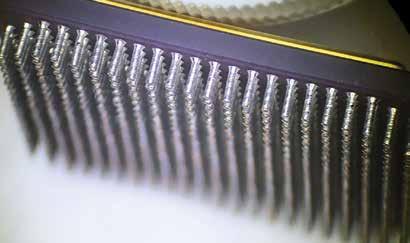
Dr. Benedetto added, “There is a need in the RadHard IC community for faster turn-times. VPT developed a CCGA process using TopLine copper wrapped columns with excellent attachment and pull-strength test results. We are working on automating the process to give customers quick turn services at competitive pricing.”
TopLine www.TopLin.tv
Abaco Announces Flexible, Rugged 4-Channel Gigabit Ethernet Interface XMC to Help Minimize Size, Weight and Power (SWaP)
• Offers choice of copper, fiber SFP connectivity • Broad range of operating system support • Simple, cost-effective upgrade for PMC676RC, PMC677RC users
Abaco Systems announced the XMC477RC 4-Channel SFP Gigabit Ethernet Interface, further expanding the company’s range of network interface card options. The new XMC is distinguished by its support for four SFP (Small Form Factor Pluggable) modules for maximum flexibility, allowing customers to choose between 1000BASE-X optical or 1000BASE-T copper connectivity. When paired with an Abaco single board computer, the XMC477RC delivers a high degree of functional density that can reduce the number of cards in a chassis – eliminating, for example, the requirement for a dedicated Ethernet switch – that can help minimize the size, weight and power (SWaP) of a subsystem.
The XMC477RC also provides a simple and highly cost-effective form-, fit- and function compatible upgrade for existing users of the PMC676RC or PMC677RC who will benefit from a more configurable product with higher throughput.
Fully rugged, with the ability to operate in temperatures between -40°C to +85°C, the XMC477RC is designed for naval/marine-, landand air platforms within defense and aerospace markets including fire control systems, airborne mission computers, radar systems and flight

control. It supports a high speed link to the host via an x4 PCIe™ connection, allowing all front I/O ports to run at full line rate.
“Minimizing size, weight and power is be
coming increasingly important to our customers as military platforms become smaller while incorporating increasing functionality – and the XMC477RC can play a key role in helping them achieve that,” said Peter Thompson, Vice President, Product Management at Abaco. “The XMC477RC further broadens our already-extensive product offering, enhancing our ability to provide customers with a complete, single source solution.”
Featuring an industry standard Intel® I350- AM4 quad port Gigabit Ethernet controller that gives native support for enhanced virtualization features such as VMDq and up to eight virtual machines a l l o c a t e d per port, the XMC477RC is easy to set up and use. It is supported by native drivers for common o p e r a t i n g systems including Microsoft Windows®, Linux® and LynxOS®. Abaco can additionally provide drivers for VxWorks® and Solaris™.
December 2019 COT’S PICKS AdaCore Introduces Support for C++ Embedded Environments GNAT Pro cross-environment handles standalone C++ and mixed-language embedded software development
AdaCore announced that its GNAT Pro product line now supports the development of embedded software written in C++. Projects using C++, either mixed with Ada or standalone, can now benefit from the same high level of quality and support that GNAT Pro Ada customers receive. GNAT Pro C++ handles versions of the language standard up to and including C++17. It is targeted to VxWorks® 7 (ARM, PowerPC, and x86), Embedded Linux (ARM, PowerPC and x86), as well as VxWorks 6.9.x (PowerPC 32 bits), and is hosted on x86 GNU Linux. It is available on both the GNAT Pro Enterprise and GNAT Pro Assurance product lines. “Embedded software teams have long been moving to multi-language development environments,” said Quentin Ochem, lead of Business Development at AdaCore. “Regardless of whether languages are intertwined in a single application, or used for separate projects, they still require the same high level of support. Our toolchains already support Ada and C for cross-development, as well as Ada, C, and C++ for native development. By adding an embedded component for C++, we can now offer our customers a truly comprehensive solution for a wide array of high integrity requirements.” “Support for C++ is critical for modern development practices and next generation system development,” said Michel Chabroux, Senior Director of Product Management at Wind River. “Wind River is pleased to be collaborating with AdaCore to ensure the industry has access to best-in-class solutions for high integrity requirements, as well as provide our joint customers with a competitive advantage.”
AdaCore www.adacore.com
Jessie Glockner, Director of Marketing and Communications, AdaCore.

GNAT Pro’s build environment is based on the multilingual GCC code generation technology, to which AdaCore has contributed and among whose official maintainers are AdaCore personnel. GNAT Pro provides advanced interfacing capabilities with Ada and C++, such as binding generation to and from both languages, mixed-language exception propagation and catching, and cross-language inheritance and dispatching. The GNAT Pro Assurance edition provides unique benefits for pure-C++ developers, including long-term support, known problem analysis, and safety-critical fixes provided by the same experts who developed the product. It also improves multiple platform portability, providing consistent technology across native and embedded environments.
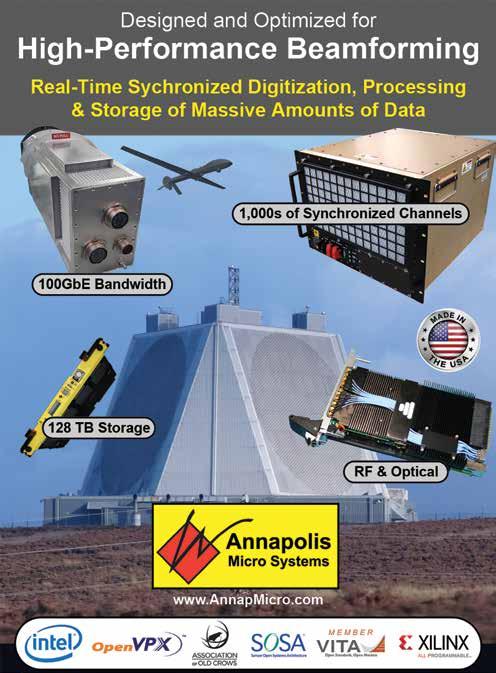
December 2019 COT’S PICKS
OSS Introduces Industry’s First Solution Incorporating NVIDIA GPUs with NVLink and Marvell ThunderX2 Arm-based Servers
OSS, Marvell and NVIDIA Demonstrate Ideal Solution for AI on the Fly® Applications
One Stop Systems, Inc. announced availability of its new SCA8000 compute acceleration expansion platform for use with Marvell® ThunderX2® Arm® based servers.
The SCA8000 includes eight NVIDIA V100 Tensor Core GPUs interconnected with NVIDIA NVLink providing 300GB/s of peer-to-peer GPU bandwidth. The SCA8000 enables up to 64GB/s of uplink bandwidth between the GPUs and Arm based servers using up to four PCI Express Gen3 x16 host interconnects.
In July, NVIDIA announced it was making available to the Arm ecosystem its full stack of AI and HPC software that accelerates more than 600 HPC applications and all AI frameworks. The stack includes all NVIDIA CUDA-X AI and HPC libraries, GPU-accelerated AI frameworks and software development tools. The SCA8000 is the industry’s only NVIDIA NVLink based solution available that leverages this NVIDIA CUDA support for the Arm processor architecture. Cable 3.0 compliant links at a distance of up to 100m.
“This new compute acceleration expansion platform demonstrates how OSS continues to be the leader in delivering the latest in high performance technology for mission critical applications,” said Steve Cooper, CEO of OSS. “We have worked closely with NVIDIA and Marvell to develop this industry-first Arm solution with NVIDIA NVLink capabilities, leading the market in enabling Arm and CUDA solutions and supporting our AI on the Fly initiatives.”
Paresh Kharya, director of product management of Accelerated Computing at NVIDIA, commented: “NVIDIA is working with the Arm ecosystem to provide the highperformance computing industry a new path to build extremely energy-efficient, AI-enabled supercomputers. The OSS expansion platform accelerated by NVIDIA GPUs with NVLink and NVIDIA’s CUDA-accelerated software provides the HPC community an easy to deploy Armbased GPU-accelerated solution.”
The resulting solution allows unparalleled scalability of multiGPU compute performance with power optimized, high-performance host processing ideal for AI on the Fly® edge applications. AI on the Fly edge appliances based on OSS technology bring datacenter AI capabilities to edge applications in military, aerospace, medical and autonomous driving. OSS’ flexible solutions provide the high bandwidth and low latency data transport needed to dramatically scale AI performance at the edge.

The SCA8000 is a 3U 8-way SXM2 expansion chassis designed to be installed in a standard 19 inch rack. It supports eight passively cooled SXM2 V100 GPU modules and has an additional 4 PCIe x16 slots to support options, such as 100/200Gb Ethernet, Infiniband or other IO and data acquisition cards. It can connect to an Arm based host server with up to four PCI-SIG PCIe Gopal Hedge, vice president and general manager of Server Processor Business Unit of Marvell Semiconductor, said: “Our collaboration with NVIDIA and OSS marks continued advancement of the ecosystem for ThunderX2, the most widely supported Arm-based server processor. ThunderX2 with NVIDIA GPUs and OSS’s NVLink based platform showcases exciting new capabilities to meet the requirements for performance and scale of AI applications.”
The Supercomputing 2019 demonstration includes a 2U server reference platform with two 32-core Arm-based Marvell ThunderX2 processors running at up to 2.5GHz in Turbo mode and supporting up to 4TB of system memory. The ThunderX2 processors provide industry-leading performance per power and memory bandwidth and high core count with hyper-threading. The server is connected to the SCA8000 populated with eight NVIDIA V100 Tensor Core GPUs interconnected with NVIDIA NVLink. ThunderX2 based servers are available from OEMs such as HPE, Bull-Atos, Cray, and GigaByte.
One Stop Systems, Inc. www.onestopsystems.com
December 2019 COT’S PICKS
New COM Express Type 10 Carrier Hosts Four AcroPack ® mPCIe I/O Modules for a Mix of Processing Functions on a Mini-ITX Platform
GNAT Pro cross-environment handles standalone C++ and mixed-language embedded software development
Acromag’s newest carrier board interfaces four I/O module slots to an Intel® Atom® COM Express, CPU module on a Mini-ITX format for a variety of data acquisition and control applications.
Acromag broadens their family of rugged AcroPack mini-PCIe I/O module carrier cards with the new Model ACEX4041 which also hosts a COM Express® Type 10 processor module. The Mini-ITX form factor board interfaces four plugin AcroPack I/O modules to an Intel Atom® E3950 (Apollo Lake) CPU module with provisions for both M.2 and SATA SSD data storage plus a variety of peripherals on-board. Ports for two RJ45 Gigabit Ethernet, two USB 3.0, two RS232, one Mini-DisplayPort, and audio connections are also included. The four AcroPack I/O slots provide a reliable PCIe mini card interface for a mix of analog, digital, serial, FPGA, avionics and other I/O functions. Four 68-pin VHDCI connectors securely route the field I/O to the AcroPack modules without any loose internal cables. AcroPack I/O modules support conduction-cooling and are rated for -40 to 85°C operation. Power is sourced from a 10-36V DC and/or ATX supply with redundant, auto-switch power capability. A development system package is offered to simplify evaluation and proof-of-concept engineering efforts in a lab. Designed for defense, industrial, and mobile embedded computing systems, the ACEX4041 is ideal for small form factor (SFF) test & measurement, data acquisition & control, communication, avionics, simulation, and signal processing applications. It is well-suited for systems with size, weight, power and cost (SWaP-C) limitations. More than 25 AcroPack modules are available to perform A/D, D/A, discrete I/O, RS232/485, MILSTD-1553, CAN bus, Gigabit Ethernet, and other functions. Third-party mPCIe modules are supported for use in the AcroPack slots. The COM Express Mini Size Type 10 slot can also host Intel Core™ i7 processors and other compatible computer-on-module processors on the market.
“This versatile SFF carrier card brings powerful modular embedded computing and flexible I/O signal processing capabilities to a standard Mini ITX platform that is easy to integrate within a custom system or mount in a rugged enclosure,” asserts Robert Greenfield, Acromag’s Business Development Manager.
AcroPack mezzanine modules improve on the mini PCI Express architecture by adding a down-facing 100-pin connector that securely routes the I/O through a carrier card to its integrated external connectors thus eliminating internal cables and metalwork modifications. More than 25 models are available for data acquisition, signal processing, test & measurement, command/control, and network communication applications. Software tools support embedded applications running on Linux®, Windows®, or VxWorks® operating systems.
Acromag Inc www.acromag.com
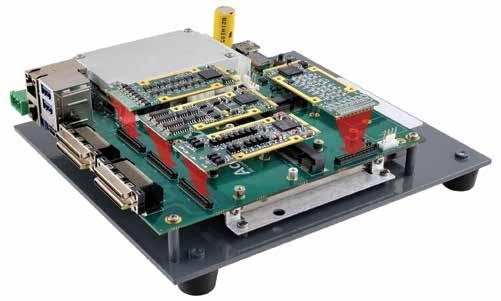
December 2019 COT’S PICKS
Pentek Announces 6.4 GHz A/D and D/A Jade 3U VPX Module for Wideband Defense, Radar and Communication Applications
• Utilizes state-of-art high-speed Texas Instruments A/Ds and D/As • Matching 6.4 GHz A/D and D/A sampling for wideband signals • 3U VPX with PCIe Gen.3x8, Optical I/O and RF I/O backplane options • Jade architecture uses Xilinx Kintex UltraScale FPGA • Navigator Design Suite supports Xilinx Graphical Vivado IP Integrator
Pentek, Inc., introduced the newest member of the Jade™ family of high-performance data converter 3U VPX modules based on the Xilinx Kintex Ultrascale FPGA. The Model 54141A is a dual channel analog-to-digital and digital-to-analog converter with sample rates up to 6.4 GHz. Programmable DDCs (digital downconverters) and DUCs (digital upconverters) support connections to IF or RF signals. For flexibility across different I/O requirements, the board can be optioned to support VITA 67.3C. This provides analog signal routing through the VPX backplane to replace front panel connectors for RF In/Out, Sample/Reference clocks and Gate/Trigger/ Sync/PPS signals. This option is often required in ruggedized deployments and for simplifying unit field replacements and upgrades.
A/D Stage and Digital Downconverter The Model 54141A uses the Texas Instruments ADC12DJ3200 12-bit A/D converter with an input bandwidth of 6 GHz, which operates in singlechannel interleaved mode with a sampling rate of 6.4 GHz or in dual-channel mode with a sampling rate of 3.2 GHz.
Digital Upconverter and D/A Stage A Texas Instruments DAC38RF82 D/A with
“The 54141A combines our popular 7114A XMC module with a 3U VPX carrier, yielding a powerful, forward-looking package for very wideband communications or radar applications that require advanced I/O resources,” said Rodger Hosking, vice-president of Pentek, Inc.
Not only does the Model 54141A comply with the VITA 65.0 3U VPX specification, it also offers flexible analog and digital interface options for the VPX P2 backplane connector to meet systemspecific requirements. In addition to its PCIe Gen.3x8 interface on the VPX P1 connector, it is possible to add up to 8 more gigabit serial lanes connected directly to the FPGA for supporting user-installed protocols.
The Model 54141A supports the emerging VITA 66.5 optical interconnect standard by providing four optical duplex lanes to a mating spring-loaded backplane connector. With the installation of a serial protocol like 10 or 40 Gigabit Ethernet in the FPGA, the interface enables high-bandwidth digital communications between boards or chassis independent of the PCIe interface.
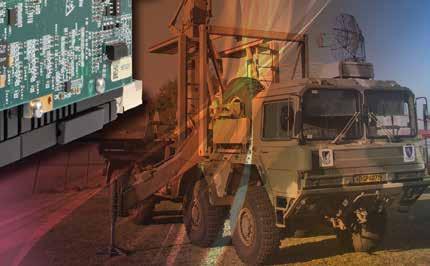
DUC accepts a baseband real or complex data stream from the FPGA and delivers it to the interpolation, upconversion and dual D/A stages for output signals up to 4 GHz. The two 6.4 GHz 14-bit D/As pair well with the dual input channels while delivering more than twice the output performance of previous generations of Pentek products.
Performance IP Cores The Model 54141A factory-installed functions include two A/D acquisition modules and a D/A waveform generation IP module. In addition, IP modules for DDR4 SDRAM memories, a controller for all data clocking and synchronization functions, a test signal generator and a PCIe Gen.3x8 interface complete the factory-installed functions. An optional VITA 49.2 data transport protocol IP module conveys digitized signal metadata for signal acquisition and processing elements in communication, radar or storage systems. System integrators get to market with less time and risk, because the Model 54141A can provide a complete turnkey acquisition/generation solution, often without the need to develop FPGA IP.
The Jade Architecture The Pentek Jade Architecture is based on the Xilinx Kintex UltraScale FPGA, which raises the digital signal processing (DSP) performance by over 50% with equally impressive reductions in cost, power dissipation and weight. As the central feature of the Jade Architecture, the FPGA has access to all data and control paths, enabling factory-installed functions including data multiplexing, channel selection, data packing, gating, triggering and memory control. A 5 GB bank of DDR4 SDRAM is available to the FPGA for custom applications. The x8 PCIe Gen 3 link can sustain 6.4 GHz data transfers to system memory. Eight additional gigabit serial lanes and LVDS general purpose I/O lines are available for custom solutions.
Navigator Design Suite for Streamlined IP Development
Pentek’s Navigator™ Design Suite consists of two components: Navigator FDK (FPGA Design Kit) for integrating custom IP into Pentek sourced designs and Navigator BSP (Board Support Package) for creating host applications. Users can work efficiently at the API level for software development and with an intuitive graphical interface for IP design. The tools reduce the development time and cost associated with complex designs. The Navigator BSP is available for Windows and Linux operating systems. Unlike others in the industry, Pentek still provides application support to customers at no cost.
Pre-Configured SPARK System Ready for Immediate Use
With a Pentek 8266 SPARK® PC, 8264 SPARK 6U VPX, or 8267 SPARK 3U VPX development system, work can begin immediately on applications. A SPARK system saves engineers time and expense associated with building and testing a development system and ensures optimum performance of Pentek boards.
December 2019 COT’S PICKS Military Grade “NO-DRONE” CounterUAS Radar Detection System Released for Airport, Facility and Event Anti Drone Protection
In response to recent threats of rogue and errant drones launched against airports and other critical facilities, infrastructure and events, 34 North Drones has partnered with IDS North America to offer and install the NO-DRONE radar counter drone system for all government and civilian clients in need of protection.
34 North Drones - Military Grade NODRONE Counter Drone-UAS Radar System for protection of airports, critical infrastructure, facilities and events available for permanent installation or rental for events, rallies, concerts, sporting events or any high risk gathering
34 North Drones Airport NO-DRONE Countermeasures system for facility and airspace protection against drones
The NO-DRONE radar detection system evolved from a proven and existing military battlefield solution originally tuned to recognize small objects such as incoming mortar, artillery and rocket fire with the ability to detect, locate and track both fixed wing and rotorcraft UAVs, Class I category (mini or small) and larger. The system provides full 360° coverage, day or night, as well as in adverse weather conditions with the ability to detect dozens and, depending on configuration, hundreds of targets simultaneously. The system can be upgraded with an optional “slew to cue” EO/IR turret and an RF detector which can be fully integrated into the system to provide substantive enhancements to drone tracking and identification capabilities.
The military, governments and certain federal agencies are authorized to use various optional drone mitigation technologies that can be integrated with the NO-DRONE system such as EMP, powerful multiband jamming, GPS spoofing or live fire systems to disable, redirect or destroy threats.
Airports are known as extraordinarily difficult environments in which to integrate and operate electronic equipment without interference with critical aircraft guidance and navigation systems. The NO-DRONE counter drone radar system utilizes a suite of EMC/EMI simulation tools for predictive assessment of possible interference between various radiating and receiving elements around the airport which models any potential interference with and from any existing NAVAIDS and COMMS equipment. These specialized tools promote safety of operations and maximize radar coverage. Comprehensive on-site technical support and training is provided to ensure successful installation and seamless ongoing operations.
The NO-DRONE system will also be available for rental with trained operators in a mobile platform for temporary use at facilities and events across the USA, and later, internationally for drone mitigation where permanent installation is not practical or needed. This includes VIP protection, outdoor concerts, sporting events, rallies and political events or any large gatherings of persons which are potentially high-risk environments. In partnership with local authorities, FBI and DHS, a protective bubble can be established around locations to mitigate the unauthorized entry by aerial threats.

Extensive demonstrations and tests at the China Lake Naval Air Weapon Station and internationally have been conducted. The system has been installed at various airports and prisons and has been used on protective details for the Pope. The NO-DRONE system is now being released through 34 North Drones for all government and civilian protection applications.
December 2019 COT’S PICKS
Eurotech Announces the DynaCOR 40- 35 Rugged NAS HPEC System
Powered by Intel® Xeon® D2100 CPUs, the new DynaCOR 40-35 delivers up to 123TB of scalable NVMe storage and 6GByte/s ultra-high speed network data transfer rates
Eurotech, has added the DynaCOR 40-35 to its High Performance Embedded Computing (HPEC) product portfolio. The DynaCOR 40-35 is a liquidcooled, customizable NAS HPEC system designed for extreme storage capacity and high speed data transfer rates in data-intensive applications at the Edge.
The DynaCOR 40-35 brings unprecedented network storage capabilities to harsh and mobile field environments: it can reach 123TB of raw capacity supporting up to 16x 7.68TB NVMe drives. Additionally, two 100 Gigabit Ethernet ports allow for sustained data transfer rates of up to 6GBytes/ second. The system also supports advanced RAID configurations to provide extra performance and data protection.
“With the DynaCOR 40-35, the Eurotech HPEC portfolio reaches a new level for rugged high-performance storage systems” commented Pierfrancesco Zuccato, Eurotech’s Senior Product Manager “This rugged HPEC NAS is an answer to the increasing demand for hyperconverged infrastructures in the field. Automotive applications, such as Level 5 Autonomous Driving, is only one example of use cases that require data-center class performance and capability in an operating environment that can be extremely harsh”.
The DynaCOR family of high performance computing and storage systems are fanless and ventless for use in a broad range of harsh environments and demanding Edge applications. The DynaCOR 40-35 compact design – only 17.7 x 19.2 x 49.5 cm - enables installation in app-lications where space is at a premium without requiring ventilation thanks to Eurotech’s advanced liquid cooling technology.

The system is pre-certified for shock/vibration and other harsh environmental and electrical certifications in a broad range of mobile and vehicular applications. It can be simply integrated in traditional, hybrid and electric vehicles thanks to an automotive isolated power supply (12VDC and 48VDC). It can also be customized to meet application-specific certifications through Eurotech Professional Services.
Eurotech www.eurotech.com
Astronics Announces a New Family of Rugged COTS Avionics Control and Communication Devices
The ‘NG’ Family is a New Generation of Ballard Boxes for Avionics Interfacing and Computing that are Secure, Right-Sized for the Application, and Ready to Deploy
Astronics Corporation is launching a new family of flexible, compact, 64-bit avionics I/O computing platforms for problem-solving and tech insertion in areas such as mission computing, distributed control and avionics data conversion.
Astronics’ NG Family of rugged Ballard Boxes provide three levels of avionics I/O capability for computing, controlling, and converting operations on military and civil platforms. (Graphic: Business Wire)
Astronics’ NG Family of rugged Ballard Boxes provide three levels of avionics I/O capability for computing, controlling, and converting operations on military and civil platforms. (Graphic: Business Wire)
The NG Family consists of three distinct series of commercial off-the-shelf (COTS) products with varying capability for use on fixed wing, UAV, rotocraft and ground vehicles. These highly-flexible, low SWaP (Size, Weight, and Power) systems include multi-protocol avionics I/O coupled with a high-throughput Ethernet backbone for inter-device communication and compatibility with a variety of avionics systems. The NG Family meets the demands of DoD open system business and technical strategies such as MOSA (Modular Open Systems Approach) and OMS (Open Mission Systems).
The NG Family shares similar design features and each variant is optimized for different levels of deployment:
• NG3 Series Avionics I/O Computers,available for order now, feature the highest level of capability and I/O, along with 64-bit processing and audio/video, for the most demanding applications.
• NG2 Series Avionics I/O Controllers,available in 2020, feature the same processing power as the NG3, but in a smaller size with a corresponding reduction of I/O, when lower SWaP is critical. • NG1 Series Avionics I/O Converters, available in 2020, are extremely compact and optimized for converting avionics protocol data to Ethernet for interfacing to the NG3/NG2 or other avionics systems.
“The NG Family builds on the success of our highly-popular and ground-breaking AB2000 and AB3000 avionics I/O computer products,” said Jon Neal, President of Astronics Ballard Technology. “The NG Family provides our large installed base of users with a direct upgrade path to 64-bit processing, robust security features and higher performance, extending the useful life of their programs for many years to come. The NG Family will also appeal to new users as flexible, problem-solving platforms for intelligence, surveillance, and reconnaissance (C4ISR) programs.”
The NG3 Series is currently ready for customer evaluation for in-progress and upcoming programs. Key features include:
• Latest Generation Intel Atom® E3950 64-bit quad core processor to run newer 64-bit operating systems that provide higher capability for today’s cybersecurity requirements.
• Rugged, maximum-density, modular architecture provides flexible I/O combinations from the factory, including MIL-STD-1553, ARINC 429, 708, 717, discrete I/O, and Ethernet. These units arrive pre-configured, pre-validated and ready for quick deployment.
• Cyber-security enablement consists of built-in tools to help customers build proprietary security solutions, including secure storage and operation, security SSD features and flexible write-protect capability. Two solid-state drive (SSD) media are user-removable and include sanitize discretes to enable users to declassify NG3 if necessary.
• Easy system migration for current AB3000 customers looking for low-risk technical refresh and insertions. This drop-in, form-fit replacement shares the same programming interface, size, and mounting configuration, with many variants being pin-to-pin compatible.
• Mini PCIe expansion slot allows I/O expansion while maintaining the ability to keep the same chassis envelope and size. This provides a low cost, low risk method to integrate additional I/O.
Index COTS ADVERTISERS COTS Company Page# Website Annapolis Micro Systems ...................................... 29 ........................................ www.annapmicro.com Avalex Technologies .............................................. 22 ................................................. www.avalex.com Behlman Electronics ............................................ BC ............................................. www.behlman.com Fairview Microwave ................................................ 27 ............................. www.fairviewmicrowave.com Kingston Technology ............................................. IBC ............................................. www.kingston.com MilesTex ................................................................ 33 ............................................. www.milestexs.com Neonode ................................................................ 14/23 ............................................... www.neonode.com New Wave DV ......................................................... 21 ......................................... www.ewwavedve.com OSS ........................................................................ IFC ................................. www.onestopsystems.com Pasternack ............................................................ 25 ......................................... www.pasternack.com Percepio ............................................................... 31 .............................................. www.percepic.com Pentek .................................................................. 5 ................................................ www.pentek.com PICO Electronics, Inc ............................................. 11 ................................... www.picoelectronics.com Sealevel ................................................................. 4 .............................................. www.sealevel.com Vicor Cororation ..................................................... 19/IBC ............. www.vicorpower.com/defense-aero.com

COTS Journal (ISSN#1526-4653) is published monthly at; 3180 Sitio Sendero, Carlsbad, CA. 92009. Periodicals Class postage paid at San Clemente and additional mailing offices. POSTMASTER: Send address changes to COTS Journal, 3180 Sitio Sendero, Carlsbad, CA. 92009.
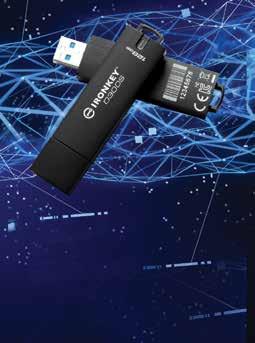
Ultra-High Voltage Bus Converter Provides 98% Efficiency
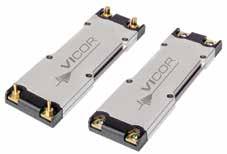


This unique K=1/16 fixed ratio bus converter sets the industry benchmark for efficiency and power density. The thermally adept VIA package simplifies customer cooling approaches in addition to providing integrated PMBus control, EMI filtering, and transient protection. These strong abilities make it ideally suited to military applications. Evaluate it today!
vicorpower.com



